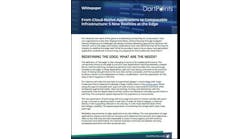Microgrids and Data Centers: A More Holistic Approach to Power Security
During last fall’s wildfires in California, the largest electric utility provider in the state was forced to shut off power for millions of customers. In early October, Pacific Gas and Electric (PG&E), curtailed power to more than 30 counties in Central and Northern California. California is prone to more wildfires, natural disasters, and inevitably, more power shutdowns, making microgrids a critical part of the infrastructure to support future operations.
This is why PG&E is planning to build 20 new microgrids near utility substations that could be affected by future power shutoffs. Communities, cities, schools and universities -and yes, data centers – are looking to microgrids to deploy more resilient power solutions above and beyond generators and traditional backup solutions.
There’s More to Microgrids Than You Think
Microgrids can bring together multiple sources of energy, offering a holistic approach rather then reliance upon a single utility provider. Microgrid solutions are entering mainstream use-cases and are delivering some serious benefits to resiliency, uptime, and power delivery. And the use-cases just keep growing. Outside of the California wildfires, there are other use-case as well.
One of the nation’s largest microgrids helps power Alcatraz Island and its 1.5 million annual visitors, helping save more than 25,000 gallons of diesel a year, while reducing the island’s fuel consumption by more than 45% since 2012. How did the Texas A&M RELLIS Campus, boasting a growing list of multimillion-dollar state and national research facilities, testbeds, and proving grounds, deliver high availability power supply for their mission? Microgrids.
In a traditional sense, microgrids act as a self-sufficient energy system. And they are capable of serving discrete geographic footprints. These locations and geographies include college campuses, hospital complexes, business centers, or entire neighborhoods.
Here’s what’s changed: Microgrid architecture has advanced from merely delivering power to doing so intelligently. Advanced microgrids are smart and leverage data-driven solutions for software and their control plane.
Rob Thornton, president and CEO of the 105-year-old International District Energy Association, often says that microgrids are “more than diesel generators with an extension cord.” In other words, a microgrid is not just a backup generation mechanism but should be a robust, 24/7/365 asset. Also, an advanced microgrid may provide grid and energy management services.
Consider this list of microgrid capabilities:
- Produce on-site generation, and, in some cases, thermal energy.
- Sell capacity, energy and ancillary services to the grid and participate in demand response — activities that create a potential revenue stream for the asset owner.
- Optimize energy resources to priorities set by the host.
- Manage load to reduce energy waste and achieve superior efficiency.
A fundamental feature of a microgrid is its ability to island — meaning it can disconnect from the central grid and operate independently and then reconnect and work in parallel with the grid. So, for example, whenever there is a significant storm or another natural weather event that potentially causes an outage on the power grid, the microgrid islands and activates its on-site power generators. When the power outage ends, the microgrid reconnects to the grid.
A microgrid controller gives the microgrid its islanding capability as well as new, data-driven capabilities. Also known as the central brain of the system, the controller can manage the generators, batteries, and nearby building energy systems with a high degree of sophistication. The controller orchestrates multiple resources to meet the energy goals established by the microgrid’s customers by increasing or decreasing the use of any of the microgrid’s resources – or combinations of resources. These types of solutions can also create microgrid-as-a-service capabilities.
Microgrid-as-a-service delivers a fully managed, data-driven solution to help you with your power delivery requirements. Advanced data gathering from numerous operational microgrid deployments allows leading partners to make better decisions and proactively service units. This type of managed offering will enable customers to never worry about their microgrid unit; it’s all serviced, monitored, and maintained by your microgrid provider.
3 Myths Regarding Microgrids and Data Centers
In researching microgrids and learning about their capabilities, I quickly ran into three myths that people still carry around this piece of technology.
- Microgrids are too expensive. Yes, there is an upfront cost of building a microgrid., which will vary depending on your use-case and the scale of the project. Some design costs are in the thousands of dollars, while more complex systems may cost more than a few million dollars. However, look at it from a healthcare data center perspective for a second. “The extreme case would be for your medical device to stop working,” says Dave Carter, the managing research engineer at the Schatz Energy Research Center and the lead technical engineer on microgrid projects. “The value of the power that the microgrid can provide when the rest of the county [in California] is de-energized is high.”
- Microgrids are way too complicated and challenging to manage. Modern microgrids are a lot smarter, automated, and data-driven than ever before. Plus, the whole design around microgrid-as-a-service enables enterprises, healthcare providers, cities, and even data center operators to focus on what they’re good at and what their business requirements. Today, the microgrid is far easier to manage, has more integration points with power solutions, and can significantly improve resiliency.
- Microgrids are basically the same as a generator. Microgrids are certainly not the same as a traditional generator. First of all, if you have a diesel generator, there is a chance that you might be limited in how much you can test it due to environmental regulations. Secondly, microgrids can be wholly independent and not rely on diesel fuel. Remember, they can source power from multiple locations. Finally, you can absolutely use a generator alongside a microgrid. Here is a specific example, there was a diesel-backed microgrid operated during Super Bowl 50 in San Francisco, California. Using Tier-4 technology, the microgrid powered Super Bowl City using renewable diesel fuel — as opposed to petroleum diesel fuel. A big difference is that this fuel is not biodiesel. Instead, it’s Neste renewable diesel, created from renewable raw materials, including any organic biomass, such as vegetable oil.
Join Bill Kleyman and other energy experts on June 23 for a live webinar on Microgrids for Data Centers – Click Here to Learn More.
Getting Started Means Asking the Right Questions
The realm of power delivery in the data center and IT space continues to become more interesting. Although power consumption is becoming more efficient, we definitely see more compute instances deployed. These instances translate to edge computing, remote locations, more distributed computing, and more ecosystem that will require access to reliable and secure power solutions.
To shift your paradigm around microgrids and power delivery, start by asking some essential questions:
- Is my power delivery as efficient as I need it to be?
- Am I worried about power outages?
- How much do I really trust my current generators?
- When was the last time I reviewed my power solution?
If you’ve never looked at microgrids as a real option for your data center, enterprise, or specific use-case, it might be an excellent moment to explore these solutions. These systems are supporting major hyperscale data centers, critical healthcare facilities, cities and towns, and even the island of Alcatraz.






